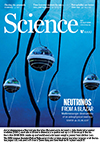 An international team of scientists, including a Canadian team led by CAP member, Dr. Darren Grant from the University of Alberta, has found the first evidence of a source of high-energy cosmic neutrinos.
An international team of scientists, including a Canadian team led by CAP member, Dr. Darren Grant from the University of Alberta, has found the first evidence of a source of high-energy cosmic neutrinos.
“The results released today are a true demonstration of the potential of the rapidly emerging fields of neutrino and multimessenger astronomy. The support provided by NSERC and Compute Canada has been invaluable to the Canadian team members*, making possible the crucial contributions to the presented measurements”, noted Dr. Grant.
IceCube Neutrinos Point to Long-Sought Cosmic Ray Accelerator
Observed by the IceCube Neutrino Observatory at the Amundsen–Scott South Pole Station, the discovery resolves a more than century-old riddle about what source could accelerate cosmic rays, such as neutrinos, to the tremendous energies recorded on earth.
 Two papers published this week in the journal Science have for the first time provided evidence for a known astronomical object called a blazar as a source of high-energy neutrinos detected by the National Science Foundation-supported IceCube observatory. This blazar, designated by astronomers as TXS 0506+056, was first singled out following a neutrino alert sent by IceCube on Sept. 22, 2017.
Two papers published this week in the journal Science have for the first time provided evidence for a known astronomical object called a blazar as a source of high-energy neutrinos detected by the National Science Foundation-supported IceCube observatory. This blazar, designated by astronomers as TXS 0506+056, was first singled out following a neutrino alert sent by IceCube on Sept. 22, 2017.
For more information, see the official IceCube press release, or contact Darren Grant, IceCube Spokesperson, Associate Professor of Physics, University of Alberta, drg@ualberta.ca.
* Currently, the IceCube Collaboration includes 300 people from 49 institutions in 12 countries. The following Canadian members were authors on the multimessenger paper and/or the Science papers:
ICECUBE –
J. Barron (U.Alberta), K. Clark (Queen’s U.), D. Grant (U.Alberta), C. Kopper (U.Alberta), R. Moore (U.Alberta),
S. Nowicki (U.Alberta), S. Sandez Herrera (U.Alberta), S. Sarkar (U.Alberta), F. Wandler (U.Alberta), C. Weaver (U.Alberta), T. Wood (U.Alberta), J. Yanez (U.Alberta)
VERITAS –
Q. Feng (McGill), T. Lin (McGill), K. Ragan (McGill), S. Trepanier (McGill), J. Tyler (McGill), B. Zitzer (McGill)
VLA (Very Large Array) –
A. Tetarenko (U.Alberta), G. Sivakoof (U.Alberta)
